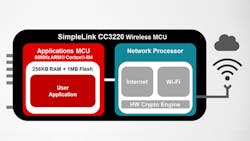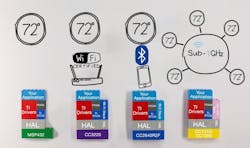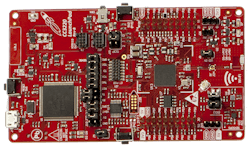Dual-core microcontrollers for the Internet of Things (IoT) are becoming more common, and this is the approach that the Texas Instruments (TI) CC3220 SimpleLink Wi-Fi MCU (Fig. 1) takes. The host processor is an 80-MHz Cortex-M4 with up to 1 Mbyte of flash storage and 256 Kbytes of RAM. It is linked to a dedicated network processor with wireless support. Wi-Fi is the initial wireless technology of choice.
The CC3210 is another version with the wireless network processor. It is controlled by an SPI link that allows developers to choose their host processor. The network processor includes a hardware crypto engine to handle secure wireless communication and secure data storage. This allows for secure wireless updates.
The systems are supported by TI’s SimpleLink SDK (Fig. 2). This provides a common API to TI’s range of wireless microcontroller solutions that also include support for Bluetooth and sub-1 GHz wireless. TI’s software provides HomeKit support.
The SimpleLink software is built on the TI RTOS. This POSIX-compatible operating system is available for free, and the POSIX support allows other RTOSes to be substituted for TI RTOS so the wireless drivers can be used in other contexts.
The SimpleLink Launchpad (Fig. 3) is available with a CC3220. It supports the CC3220’s interfaces, including SPI, I2C, UART, SD, and camera interface. It has a full complement of timers and PWM counters. Analog support includes a 12-bit ADC.
About the Author
William G. Wong
Senior Content Director - Electronic Design and Microwaves & RF
I am Editor of Electronic Design focusing on embedded, software, and systems. As Senior Content Director, I also manage Microwaves & RF and I work with a great team of editors to provide engineers, programmers, developers and technical managers with interesting and useful articles and videos on a regular basis. Check out our free newsletters to see the latest content.
You can send press releases for new products for possible coverage on the website. I am also interested in receiving contributed articles for publishing on our website. Use our template and send to me along with a signed release form.
Check out my blog, AltEmbedded on Electronic Design, as well as his latest articles on this site that are listed below.
You can visit my social media via these links:
- AltEmbedded on Electronic Design
- Bill Wong on Facebook
- @AltEmbedded on Twitter
- Bill Wong on LinkedIn
I earned a Bachelor of Electrical Engineering at the Georgia Institute of Technology and a Masters in Computer Science from Rutgers University. I still do a bit of programming using everything from C and C++ to Rust and Ada/SPARK. I do a bit of PHP programming for Drupal websites. I have posted a few Drupal modules.
I still get a hand on software and electronic hardware. Some of this can be found on our Kit Close-Up video series. You can also see me on many of our TechXchange Talk videos. I am interested in a range of projects from robotics to artificial intelligence.





